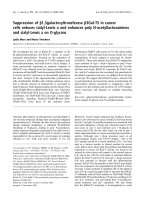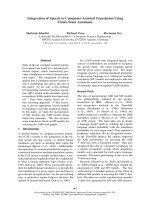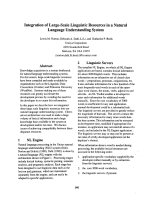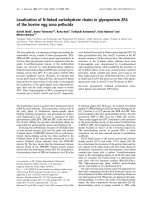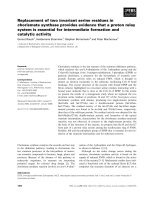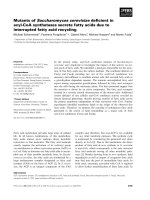Báo cáo khoa học: "Integration Of Visual Inter-word Linguistic Knowledge In Degraded Constraints And Text Recognition" doc
Bạn đang xem bản rút gọn của tài liệu. Xem và tải ngay bản đầy đủ của tài liệu tại đây (305.17 KB, 3 trang )
Integration Of Visual Inter-word Constraints And
Linguistic Knowledge In Degraded Text Recognition
Tao Hong
Center of Excellence for Document Analysis and Recognition
Department of Computer Science
State University of New York at Buffalo, Buffalo, NY 14260
t aohong@cs, buffalo, edu
Abstract 1 2 3 4
Degraded text recognition is a difficult task. Given a Please fin in tire
noisy text image, a word recognizer can be applied to 0.90 0.33 0.30 0.80
Fleece
fill In
toe
generate several candidates for each word image. High- o. o5 o. 30 o. 28 o. io
level knowledge sources can then be used to select a
Pierce flu io lire
decision from the candidate set for each word image. 0.02 0.21 0.25 0.05
In this paper, we propose that visual inter-word con- Fierce flit ill the
straints can be used to facilitate candidate selection. 0.02 o. 10 o. 13 0.03
Visual inter-word constraints provide a way to link word Pieces till Io Ike
images inside the text page, and to interpret them sys- 0.01 0.o6 0.04 0.02
tematically.
Introduction
The objective of visual text recognition is to transform
an arbitrary image of text into its symbolic equivalent
correctly. Recent technical advances in the area of doc-
ument recognition have made automatic text recogni-
tion a viable alternative to manual key entry. Given a
high quality text page, a commercial document recog-
nition system can recognize the words on the page at
a high correct rate. However, given a degraded text
page, such as a multiple-generation photocopy or fac-
simile, performance usually drops abruptly([1]).
Given a degraded text image, word images can be ex-
tracted after layout analysis. A word image from a de-
graded text page may have touching characters, broken
characters, distorted or blurred characters, which may
make the word image difficult to recognize accurately.
After character recognition and correction based on dic-
tionary look-up, a word recognizer will provide one or
more word candidates for each word image. Figure 1
lists the word candidate sets for the sentence, "Please
fill in the application form." Each word candidate has
a confidence score, but the score may not be reliable
because of noise in the image. The correct word candi-
date is usually in the candidate set, but may not be the
candidate with the highest confidence score. Instead of
simply picking up the word candidate with the high-
est recognition score, which may make the correct rate
quite low, we need to find a method which can select a
candidate for each word image so that the correct rate
can be as high as possible.
Contextual information and high-level knowledge can
be used to select a decision word for each word image
5 6 7
application farm !
0.90 0.35
applicators form
0.05 0.30
acquisition forth
0.03 0.20
duplication
foam
0.01 0.11
implication
force
0.01 0.04
Figure 1: Candidate Sets for the Sentence:
in the application form/"
"Please fill
in its context. Currently, there are two approaches,
the statistical approach and the structural approach,
towards the problem of candidate selection. In the sta-
tistical approach, language models, such as a Hidden
Marker Model and word collocation can be utilized for
candidate selection ([2, 4, 5]). In the structural ap-
proach, lattice parsing techniques have been developed
for candidate selection([3, 7]).
The contextual constraints considered in a statisti-
cal language model, such as word collocation, are local
constraints. For a word image, a candidate will be se-
lected according to the candidate information from its
neighboring word images in a fixed window size. The
window size is usually set as one or two. In the lattice
parsing method, a grammar is used to select a candi-
date for each word image inside a sentence so that the
sequence of those selected candidates form a grammat-
ical and meaningful sentence. For example, consider
the sentence "Please fill in the application form". We
assume all words except the word "form" have been
recognized correctly and the candidate set for the word
"form" is { farm, form, forth, foam, forth } (see the
second sentence in Figure 2). The candidate "form"
can be selected easily because the collocation between
"application" and "form" is strong and the resulting
sentence is grammatical.
The contextual information inside a small window or
inside a sentence sometimes may not be enough to select
a candidate correctly. For example, consider the sen-
328
Sentence 1
1
This
2
farm
form
forth
foam
force
11 12
Please fill
3 4 5 6 7 8 9 10
is almost the same as that
one
Sentence 2
13 14 15 16 17
in the application farm !
form
forth
foam
force
Figure 2: Word candidates of two example sen-
tences(word images 2 and 16 are similar)
®
skill; it iologica-t)ly based. LanKua ze
is ometh ing-G'K born
how to,'g_,,_zo_v¢. Yet hypofl\esis that
%h re t9Io:gicat unde. innings to
human linguistic abili W does not ex-
plain eve,-:ything. There may indeed
versal elements. All ,k((dK'f tan,ma -,es z
s@certam orgamz a tional principles.
Figure 3: Part of text page with three sentences
tence
"This form is almost the same as that one"(see
the first sentence in Figure 2). Word image
16
has five
candidates: {
farm, form, forth, foam, forth
}. After
lattice parsing, the candidate
"forth"
will be removed
because it does not fit the context. But it is difficult
to select a candidate from
"farm", "form" "foam"
and
"force"
because each of them makes the sentence gram-
matical and meaningful. In such a case, more contex-
tual constraints are needed to distinguish the remaining
candidates and to select the correct one.
Let's further assume that the sentences in Figure 2
are from the same text. By image matching, we know
word images 2 and
16
are visually similar. If two word
images are almost the same, they must be the same
word. Therefore, same candidates must be selected for
word image 2 and word image
16,
After
"form"
is chosen
for image
16
it can also be chosen as the decision for
image 2.
Possible Relations between W1. and W2
type at symbolic level at image level
W1 W2
W2=XeWleY
prefix_of(W1) =
prefix_of(W2)
suf yiz_oy(W1) =
~u y yix_o y(W2 )
suyyiz_of(WQ =
prefiz_of(W~)
Note 1: "~" means approximately
Note 2: "e" means concatenation.
VV-~ ~ W2
W1 ~ subimage_of(W2)
left_part_of(W1) ,~
left_part_of(W2)
right_part_of(W1)
right_part_of(W2)
right_part_of(W1) ,.~
left_part_of(W2)
image matching;
Table 1: Possible Inter-word Relations
Visual Inter-Word Relations
A visual inter-word relation can be defined between two
word images if they share the same pattern at the image
level. There are five types of visual inter-word relations
listed in the right part of Table 1. Figure 3 is a part of
a scanned text image in which a small number of word
relations are circled to demonstrate the abundance of
inter-word relations defined above even in such a small
fragment of a real text page. Word images 2 and 8 are
almost the same. Word image 9 matches the left part
of word image 1 quite well. Word image 5 matches a
part of the image 6, and so on.
Visual inter-word relations can be computed by ap-
plying simple image matching techniques. They can be
calculated in clean text images, as well as in highly de-
graded text fmages, because the word images, due to
their relatively large size, are tolerant to noise ([6]).
Visual inter-word relations can be used as constraints
in the process of word image interpretation, especially
for candidate selection. It is not surprising that word
relations at the image level are highly consistent with
word relations at the symbolic level(see Table 1). If two
words hold a relation at the symbolic level and they are
written in the same font and size, their word images
should keep the same relation at the image level. And
also, if two word images hold a relation at the image
level, the truth values of the word images should have
the same relation at the symbolic level. In Figure 3,
word images 2 and 8 must be recognized as the same
word because they can match each other; the identity
of word image 5 must be a sub-string of the identity of
word image 6 because word image 5 can match with a
part of word image 6; and so on.
Visual inter-word constraints provide us a way to link
word images inside a text page, and to interpret them
systematically. The research discussed in this paper in-
tegrates visual inter-word constraints with a statistical
language model and a lattice parser to improve the per-
formance of candidate selection.
329
Current Status of Work
A word-collocation-based relaxation algorithm and
a probabilistic lattice chart parser have been de-
signed for word candidate selection in degraded text
recognition([3, 4]). The relaxation algorithm runs iter-
atively. In each iteration, the confidence score of each
candidate is adjusted based on its current confidence
and its collocation scores with the currently most pre-
ferred candidates for its neighboring word images. Re-
laxation ends when all candidates reach a stable state.
For each word image, those candidates with a low con-
fidence score will be removed from the candidate sets.
Then, the probabilistic lattice chart parser will be ap-
plied to the reduced candidate sets to select the can-
didates that appear in the most preferred parse trees
built by the parser. There can be different strategies to
use visual inter-word constraints inside the relaxation
algorithm and the lattice parser. One of the strategies
we are exploiting is to re-evaluate the top candidates
for the related word images after each iteration of re-
laxation or after lattice parsing. If they hold the same
relation at the symbolic level, the confidence scores of
the candidates will be increased. Otherwise, the images
with a low confidence score will follow the decision of
the images with a high confidence score.
Five articles from the Brown Corpus were chosen ran-
domly as testing samples. They are A06, GO2, J42, NO1
and ROT, each with about %000 words. Given a word
image, our word recognizer generates its top10 candi-
dates from a dictionary with 70,000 different entries.
In preliminary experiments, we exploit only the type-1
relation listed in Table 1. After clustering word im-
ages by image matching, similar images will be in the
same cluster. Any two images from the same cluster
hold the type-1 relation. Word collocation data were
trained from the Penn Treebank and the Brown Cor-
pus except for the five testing samples. Table 2 shows
results of candidate selection with and without using
visual inter-word constraints. The top1 correct rate for
candidate lists generated by a word recognizer is as low
as 57.1%, Without using visual inter-word constraints,
the correct rate of candidate selection by relaxation and
lattice parsing is 83.1%. After using visual inter-word
constraints, the correct rate becomes 88.2%.
Article
Number
Of
Words
A06 2213
G02 2267
J42 2269
N01 2313
R07 2340
Total 11402
Word
Recognition
Result
53.8%
67.7%
54.5%
57.3%
52.2%
57.1%
Candidate Selection
Using No Using
Constraints Constraints
83.1% 88.5%
83.8% 87.8%
83.6% 89.5%
82.7% 87.1%
82.6% 88.1%
83.1% 88.2%
Table 2: Comparison Of Candidate Selection Results
Conclusions and Future Directions
Integration of natural language processing and image
processing is a new area of interest in document anal-
ysis. Word candidate selection is a problem we are
faced with in degraded text recognition, as well as in
handwriting recognition. Statistical language models
and lattice parsers have been designed for the prob-
lem. Visual inter-word constraints in a text page can
be used with linguistic knowledge sources to facilitate
candidate selection. Preliminary experimental results
show that the performance of candidate selection is im-
proved significantly although only one inter-word rela-
tion was used. The next step is to fully integrate visual
inter-word constraints and linguistic knowledge sources
in the relaxation algorithm and the lattice parser.
Acknowledgments
I would like to thank Jonathan J. Hull for his support
and his helpful comments on drafts of this paper.
References
[1] Henry S. Baird, "Document Image Defect Models
and Their Uses," in Proceedings of the Second In-
ternational Conference on Document Analysis and
Recognition ICDAR-93, Tsukuba, Japan, October
20-22, 1993, pp. 62-67.
[2] Kenneth Ward Church and Patrick Hanks, "Word
Association Norms, Mutual Information, and Lexi-
cography," Computational Linguistics, Vol. 16, No.
1, pp. 22-29, 1990.
[3] Tao Hong and Jonathan J. Hull, "Text Recognition
Enhancement with a Probabilistic Lattice Chart
Parser," in Proceedings of the Second International
Conference on Document Analysis and Recognition
ICDAR-93, Tsukuba, Japan, October 20-22, 1993.
[4] Tao Hong and Jonathan J. Hull, "Degraded Text
Recognition Using Word Collocation," in Pro-
ceedings of IS~T/SPIE Symposium on Document
Recognition, San Jose, CA, February 6-10, 1994.
[5] Jonathan J. Hull, "A Hidden Markov Model for
Language Syntax in Text Recognition," in Pro-
ceedings of llth IAPR International Conference on
Pattern Recognition, The Hague, The Netherlands,
pp.124-127, 1992.
[6] Siamak Khoubyari and Jonathan J. Hull, "Keyword
Location in Noisy Document Image," in Proceed-
ings of the Second Annual Symposium on Docu-
ment Analysis and Information Retrieval, Las Ve-
gas, Nevada, pp. 217-231, April 26-28, 1993.
[7] Masaru Tomita, "An Efficient Word Lattice Pars-
ing Algorithm for Continuous Speech Recognition,"
in Proceedings of the International Conference on
Acoustic, Speech and Signal Processing, 1986.
330



